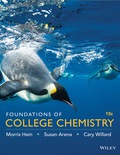
EBK FOUNDATIONS OF COLLEGE CHEMISTRY
15th Edition
ISBN: 9781118930144
Author: Willard
Publisher: JOHN WILEY+SONS INC.
expand_more
expand_more
format_list_bulleted
Question
Chapter 6, Problem 5RQ
(a)
Interpretation Introduction
Interpretation:
The formula of the compound formed from potassium and sulfide has to be written.
(b)
Interpretation Introduction
Interpretation:
The formula of the compound formed from cobalt (II) and bromate has to be written.
(c)
Interpretation Introduction
Interpretation:
The formula of the compound formed from ammonium and nitrate has to be written.
(d)
Interpretation Introduction
Interpretation:
The formula of the compound formed from hydrogen and phosphate has to be written.
(e)
Interpretation Introduction
Interpretation:
The formula of the compound formed from iron (III) and oxide has to be written.
(f)
Interpretation Introduction
Interpretation:
The formula of the compound formed from magnesium and hydroxide has to be written.
Expert Solution & Answer
Want to see the full answer?
Check out a sample textbook solution
Students have asked these similar questions
Which of the m/z values corresponds to the base peak in the mass spectrum shown?
100
80
A. 45
B. 44
C. 29
D. 15
Intensity
20
0
10 20
30 40
B-
m/z
-8
50
E. 30
Which of the m/z values correspond to the molecular ion for the compound shown?
A. 18
B. 82
OH
C. 100
D. 102
E. 103
Can someone help me with drawing my arrows.
Can I get help drawing my arrows #2
Chapter 6 Solutions
EBK FOUNDATIONS OF COLLEGE CHEMISTRY
Ch. 6.2 - Prob. 6.1PCh. 6.3 - Prob. 6.2PCh. 6.4 - Prob. 6.3PCh. 6.4 - Prob. 6.4PCh. 6.4 - Prob. 6.5PCh. 6.4 - Prob. 6.6PCh. 6.4 - Prob. 6.7PCh. 6.5 - Prob. 6.8PCh. 6.5 - Prob. 6.9PCh. 6.6 - Prob. 6.10P
Ch. 6.6 - Prob. 6.11PCh. 6 - Prob. 1RQCh. 6 - Prob. 2RQCh. 6 - Prob. 3RQCh. 6 - Prob. 4RQCh. 6 - Prob. 5RQCh. 6 - Prob. 6RQCh. 6 - Prob. 7RQCh. 6 - Prob. 8RQCh. 6 - Prob. 9RQCh. 6 - Prob. 10RQCh. 6 - Prob. 11RQCh. 6 - Prob. 12RQCh. 6 - Prob. 1PECh. 6 - Prob. 2PECh. 6 - Prob. 3PECh. 6 - Prob. 4PECh. 6 - Prob. 5PECh. 6 - Prob. 6PECh. 6 - Prob. 7PECh. 6 - Prob. 8PECh. 6 - Prob. 9PECh. 6 - Prob. 10PECh. 6 - Prob. 11PECh. 6 - Prob. 12PECh. 6 - Prob. 13PECh. 6 - Prob. 14PECh. 6 - Prob. 15PECh. 6 - Prob. 16PECh. 6 - Prob. 17PECh. 6 - Prob. 18PECh. 6 - Prob. 19PECh. 6 - Prob. 20PECh. 6 - Prob. 21PECh. 6 - Prob. 22PECh. 6 - Prob. 23PECh. 6 - Prob. 24PECh. 6 - Prob. 25PECh. 6 - Prob. 26PECh. 6 - Prob. 27PECh. 6 - Prob. 28PECh. 6 - Prob. 29AECh. 6 - Prob. 30AECh. 6 - Prob. 31AECh. 6 - Prob. 32AECh. 6 - Prob. 33AECh. 6 - Prob. 34AECh. 6 - Prob. 35AECh. 6 - Prob. 36AECh. 6 - Prob. 37AECh. 6 - Prob. 38AECh. 6 - Prob. 39AECh. 6 - Prob. 40AECh. 6 - Prob. 41AECh. 6 - Prob. 42AECh. 6 - Prob. 44CE
Knowledge Booster
Similar questions
- Can I get some help with my arrows? I have included what the final outcome needs to look like. #3arrow_forwardPlease explain how to calculate the pH.arrow_forwardI'm having trouble with converting lewis diagrams into VSEPR diagrams. I currently have this example of C2BrCl3 which I want to turn into a lewis structure, but I'm not sure what steps I need to do in order to do so. I have the table written down, however, there's two central atoms so what would I do? There seems to be 4 electron domains on the carbon atom and no lone pairs so it would seem like this shape would be tetrahedral. Here's what I have now. Thanks!arrow_forward
- We discussed the solid phase resin using in peptide synthesis. Provide a mechanism, for its formation. DRAW THE MECHANISM.arrow_forwardPlease help. Every time I've asked an expert in the past, it's been wrong :(arrow_forwardPlease help everysingle time ive asked in the past, the solution has been wrongarrow_forward
- Please helparrow_forward(a) 21.8 Name the following compounds. & (b) Br (e) O₂N. (h) H (c) Br (d) NH2 ☑N Br H ہیں Ph (g) OMe бл .0-0.e 21.9 Draw a structural formula for each compound. (a) 2,3-Dinitrotoluene (c) Diphenylmethanol (e) p-Nitroaniline (b) 3-Propylanisole (d) m-Propylphenol (f) Pentabromobenzenearrow_forwardIs this the major product of this reaction?arrow_forward
arrow_back_ios
SEE MORE QUESTIONS
arrow_forward_ios
Recommended textbooks for you
 Chemistry: Principles and PracticeChemistryISBN:9780534420123Author:Daniel L. Reger, Scott R. Goode, David W. Ball, Edward MercerPublisher:Cengage Learning
Chemistry: Principles and PracticeChemistryISBN:9780534420123Author:Daniel L. Reger, Scott R. Goode, David W. Ball, Edward MercerPublisher:Cengage Learning Living By Chemistry: First Edition TextbookChemistryISBN:9781559539418Author:Angelica StacyPublisher:MAC HIGHER
Living By Chemistry: First Edition TextbookChemistryISBN:9781559539418Author:Angelica StacyPublisher:MAC HIGHER Introductory Chemistry: A FoundationChemistryISBN:9781337399425Author:Steven S. Zumdahl, Donald J. DeCostePublisher:Cengage Learning
Introductory Chemistry: A FoundationChemistryISBN:9781337399425Author:Steven S. Zumdahl, Donald J. DeCostePublisher:Cengage Learning World of Chemistry, 3rd editionChemistryISBN:9781133109655Author:Steven S. Zumdahl, Susan L. Zumdahl, Donald J. DeCostePublisher:Brooks / Cole / Cengage Learning
World of Chemistry, 3rd editionChemistryISBN:9781133109655Author:Steven S. Zumdahl, Susan L. Zumdahl, Donald J. DeCostePublisher:Brooks / Cole / Cengage Learning Chemistry: The Molecular ScienceChemistryISBN:9781285199047Author:John W. Moore, Conrad L. StanitskiPublisher:Cengage Learning
Chemistry: The Molecular ScienceChemistryISBN:9781285199047Author:John W. Moore, Conrad L. StanitskiPublisher:Cengage Learning

Chemistry: Principles and Practice
Chemistry
ISBN:9780534420123
Author:Daniel L. Reger, Scott R. Goode, David W. Ball, Edward Mercer
Publisher:Cengage Learning

Living By Chemistry: First Edition Textbook
Chemistry
ISBN:9781559539418
Author:Angelica Stacy
Publisher:MAC HIGHER

Introductory Chemistry: A Foundation
Chemistry
ISBN:9781337399425
Author:Steven S. Zumdahl, Donald J. DeCoste
Publisher:Cengage Learning

World of Chemistry, 3rd edition
Chemistry
ISBN:9781133109655
Author:Steven S. Zumdahl, Susan L. Zumdahl, Donald J. DeCoste
Publisher:Brooks / Cole / Cengage Learning


Chemistry: The Molecular Science
Chemistry
ISBN:9781285199047
Author:John W. Moore, Conrad L. Stanitski
Publisher:Cengage Learning